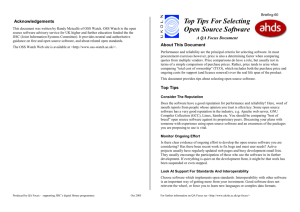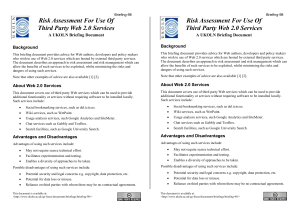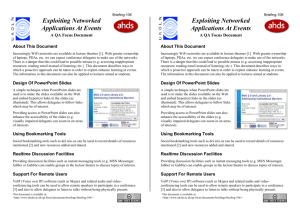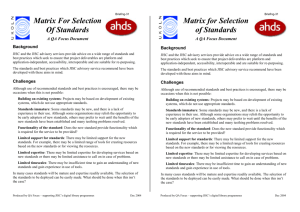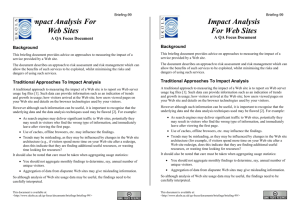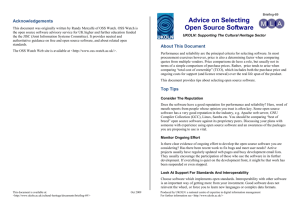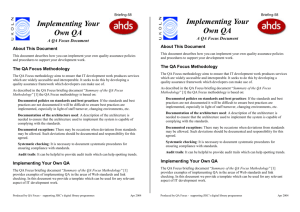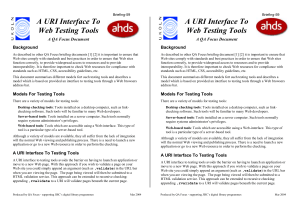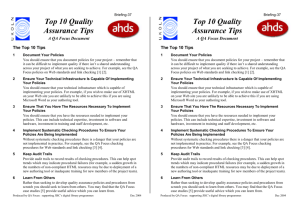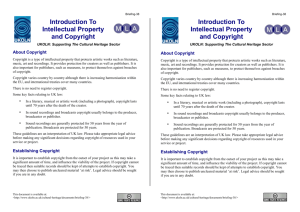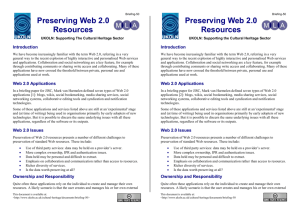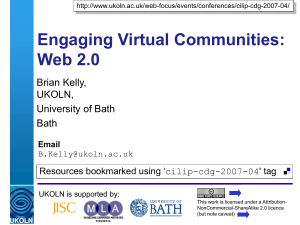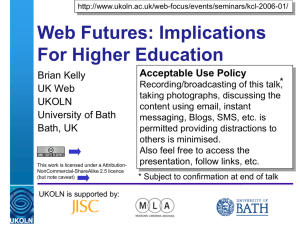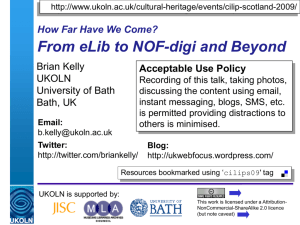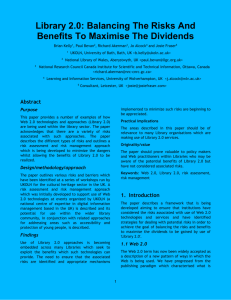An Introduction To Web 2.0
advertisement
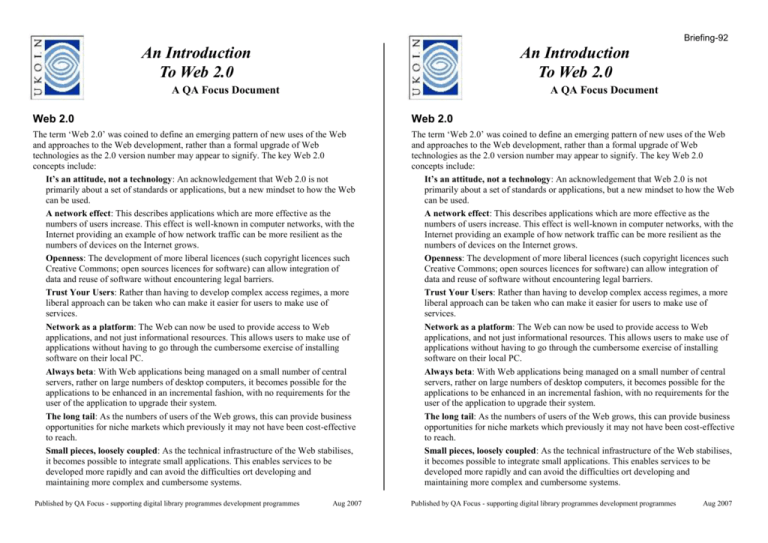
Briefing-92 An Introduction To Web 2.0 An Introduction To Web 2.0 A QA Focus Document A QA Focus Document Web 2.0 Web 2.0 The term ‘Web 2.0’ was coined to define an emerging pattern of new uses of the Web and approaches to the Web development, rather than a formal upgrade of Web technologies as the 2.0 version number may appear to signify. The key Web 2.0 concepts include: It’s an attitude, not a technology: An acknowledgement that Web 2.0 is not primarily about a set of standards or applications, but a new mindset to how the Web can be used. A network effect: This describes applications which are more effective as the numbers of users increase. This effect is well-known in computer networks, with the Internet providing an example of how network traffic can be more resilient as the numbers of devices on the Internet grows. Openness: The development of more liberal licences (such copyright licences such Creative Commons; open sources licences for software) can allow integration of data and reuse of software without encountering legal barriers. Trust Your Users: Rather than having to develop complex access regimes, a more liberal approach can be taken who can make it easier for users to make use of services. Network as a platform: The Web can now be used to provide access to Web applications, and not just informational resources. This allows users to make use of applications without having to go through the cumbersome exercise of installing software on their local PC. Always beta: With Web applications being managed on a small number of central servers, rather on large numbers of desktop computers, it becomes possible for the applications to be enhanced in an incremental fashion, with no requirements for the user of the application to upgrade their system. The long tail: As the numbers of users of the Web grows, this can provide business opportunities for niche markets which previously it may not have been cost-effective to reach. Small pieces, loosely coupled: As the technical infrastructure of the Web stabilises, it becomes possible to integrate small applications. This enables services to be developed more rapidly and can avoid the difficulties ort developing and maintaining more complex and cumbersome systems. The term ‘Web 2.0’ was coined to define an emerging pattern of new uses of the Web and approaches to the Web development, rather than a formal upgrade of Web technologies as the 2.0 version number may appear to signify. The key Web 2.0 concepts include: It’s an attitude, not a technology: An acknowledgement that Web 2.0 is not primarily about a set of standards or applications, but a new mindset to how the Web can be used. A network effect: This describes applications which are more effective as the numbers of users increase. This effect is well-known in computer networks, with the Internet providing an example of how network traffic can be more resilient as the numbers of devices on the Internet grows. Openness: The development of more liberal licences (such copyright licences such Creative Commons; open sources licences for software) can allow integration of data and reuse of software without encountering legal barriers. Trust Your Users: Rather than having to develop complex access regimes, a more liberal approach can be taken who can make it easier for users to make use of services. Network as a platform: The Web can now be used to provide access to Web applications, and not just informational resources. This allows users to make use of applications without having to go through the cumbersome exercise of installing software on their local PC. Always beta: With Web applications being managed on a small number of central servers, rather on large numbers of desktop computers, it becomes possible for the applications to be enhanced in an incremental fashion, with no requirements for the user of the application to upgrade their system. The long tail: As the numbers of users of the Web grows, this can provide business opportunities for niche markets which previously it may not have been cost-effective to reach. Small pieces, loosely coupled: As the technical infrastructure of the Web stabilises, it becomes possible to integrate small applications. This enables services to be developed more rapidly and can avoid the difficulties ort developing and maintaining more complex and cumbersome systems. Published by QA Focus - supporting digital library programmes development programmes Published by QA Focus - supporting digital library programmes development programmes Aug 2007 Aug 2007 Web 2.0 Application Areas Web 2.0 Application Areas The key application areas which embody the Web 2.0 concepts include: Blogs: A Web site which is commonly used to provide diaries, with entries provided in chronological order. Blogs can be used for a variety of purposes, ranging from reflective learning by students and researchers through to dissemination channels for organisations. Wikis: A wiki refers to a collaborative Web-based authoring environment. The term wiki comes from an Hawaiian word meaning ‘quick’ and the origins of the name reflect the aims of the original design of wikis to provide a very simple authoring environment which allows Web content to be created with the need to learn the HTML language or to install and master HTML authoring tools. Syndicated content: RSS and Atom formats have been developed to enable content to be automatically embedded elsewhere. RSS was initially developed to support reuse of blog content produced. RSS’s success led to the format being used in other areas (initially for the syndication of news feeds and then for other alerting purposes and general syndication of content). The Atom format was developed as an alternative to RSS. Mashups: A mashup is a service which contains data and services combined from multiple sources. A common example of a mashup is a Google Maps mashup which integrated location data was a map provided by the Google Maps service. Podcasts: A podcast initially referred to syndicated audio content, which can be transferred automatically to portable MP3 players, such as iPods. However the term is sometimes misused to describe a simple audio file. Social sharing services: Applications which provide sharing of various types of resources such as bookmarks, photographs, etc. Popular examples of social sharing services include del.icio.us and Flickr. Social networks: Communal spaces which can be used for group discussions and sharing of resources. Folksonomies and tagging: A bottom-up approach to providing labels for resources, to allow them to be retrieved. The key application areas which embody the Web 2.0 concepts include: Blogs: A Web site which is commonly used to provide diaries, with entries provided in chronological order. Blogs can be used for a variety of purposes, ranging from reflective learning by students and researchers through to dissemination channels for organisations. Wikis: A wiki refers to a collaborative Web-based authoring environment. The term wiki comes from an Hawaiian word meaning ‘quick’ and the origins of the name reflect the aims of the original design of wikis to provide a very simple authoring environment which allows Web content to be created with the need to learn the HTML language or to install and master HTML authoring tools. Syndicated content: RSS and Atom formats have been developed to enable content to be automatically embedded elsewhere. RSS was initially developed to support reuse of blog content produced. RSS’s success led to the format being used in other areas (initially for the syndication of news feeds and then for other alerting purposes and general syndication of content). The Atom format was developed as an alternative to RSS. Mashups: A mashup is a service which contains data and services combined from multiple sources. A common example of a mashup is a Google Maps mashup which integrated location data was a map provided by the Google Maps service. Podcasts: A podcast initially referred to syndicated audio content, which can be transferred automatically to portable MP3 players, such as iPods. However the term is sometimes misused to describe a simple audio file. Social sharing services: Applications which provide sharing of various types of resources such as bookmarks, photographs, etc. Popular examples of social sharing services include del.icio.us and Flickr. Social networks: Communal spaces which can be used for group discussions and sharing of resources. Folksonomies and tagging: A bottom-up approach to providing labels for resources, to allow them to be retrieved. Further Information Further Information An Introduction to RSS and News Feeds, QA Focus document 77, UKOLN, <http://www.ukoln.ac.uk/qa-focus/documents/briefings/briefing-77/> An Introduction to RSS and News Feeds, QA Focus document 77, UKOLN, <http://www.ukoln.ac.uk/qa-focus/documents/briefings/briefing-77/> An Introduction to Wikis, QA Focus document 78, UKOLN, <http://www.ukoln.ac.uk/qa-focus/documents/briefings/briefing-78/> An Introduction to Wikis, QA Focus document 78, UKOLN, <http://www.ukoln.ac.uk/qa-focus/documents/briefings/briefing-78/> Web 2.0: Supporting Library Users, QA Focus document 102, UKOLN, <http://www.ukoln.ac.uk/qa-focus/documents/briefings/briefing-102/> Web 2.0: Supporting Library Users, QA Focus document 102, UKOLN, <http://www.ukoln.ac.uk/qa-focus/documents/briefings/briefing-102/> This document is available at: <http://www.ukoln.ac.uk/qa-focus/documents/briefings/briefing-92/> This document is available at: <http://www.ukoln.ac.uk/qa-focus/documents/briefings/briefing-92/>
